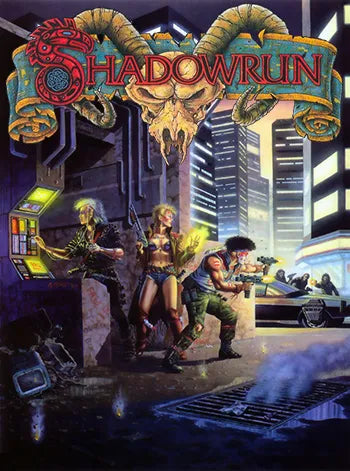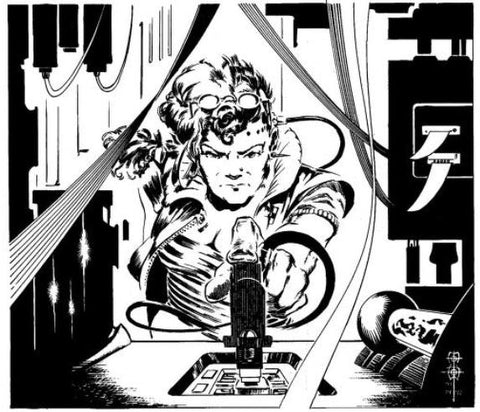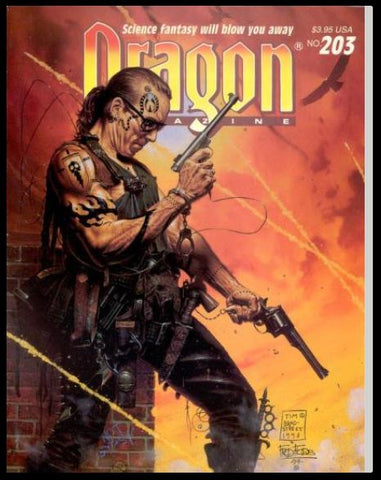For obvious reasons, most of the content found in Dragon Magazine is for Dungeons and Dragons. But that doesn’t mean that no other games are ever discussed! In fact, sections for Marvel roleplaying, outlining stats for different characters, are an extremely common feature to be found. There are also tons of reviews for different games, and even progress reports for games as they were being developed.
One game that I’m always happy to see content for is Shadowrun. And in March 2024, Dragon published an article titled “Lookin’ for Work, Chummer?” by Gregory W. Detwiler featuring just that game.
You can read the full article here: Dragon Magazine #203
What is Shadowrun?

Shadowrun is a science-fantasy tabletop gaming system published first by FASA in 1989, then by WizKids, and currently by Catalyst Games. It combines high tech and high fantasy to create a dystopian cyberpunk future filled with elves, dragons, spells, and powerful corporations that rule the lives of the population. In it, players take on the role of ‘shadowrunners’, specialist outlaws who make a living doing shady jobs against (or for) those corporations, stealing data, slinging spells, and generally causing mayhem.
Ideas and Content of “Lookin’ for Work, Chummer?”
“Lookin’ for Work, Chummer?” is a primer for a DM starting out in the universe of Shadowrun. It goes over several types of missions that fit well in the setting, detailing why each style of mission might be undertaken, the kinds of characters who fit for each, and common variations you can add to keep things interesting. Then, it goes through a few sample missions with more specific ideas for sessions. Finally, it brings up ‘player flexibility’, which it looks at in a slightly different way than it is usually discussed nowadays (more on that in a moment).

Mission Types in Shadowrun
This article goes over 7 (or 8) different mission types you might have your players run.
- Corporate Extraction: Players infiltrate and steal information, items, or employees from a corporation. It’s usually for another company, but might also be for a third party.
- Reverse Extraction: Technically a variation of the corporate extraction, players rescue someone or something that has been stolen from a company.
- Security Guards: Players turn their expertise in stealing on its head, instead planning to fend off other shadowrunners from a particular target.
- Collections: Players attempt to collect something that doesn’t have the usual corporate protections, but that is otherwise dangerous to find, like rare minerals, spell components, or monster parts.
- Smuggling: Players sneak contraband items from one area to another, avoiding detection.
- Espionage: Players infiltrate an organization and steal information or items, but by means of observation (usually after being accepted into the organization) instead of outright theft. This may also include sabotage or other more direct damage to the organization.
- Wetwork: Players assassinate a particular individual or group of individuals.
- Combat: Players cause violence; starting fights with whole gangs, taking out entire squads (usually of security or other shadowrunner), or running off small populations. This is often wetwork on a large scale, but not always.
What is “Player Flexibility”?

When most people talk about player flexibility today, they’re referring to players' ability to roll with the punches and think outside the box. But they’re generally assuming that people are using that creativity and flexibility for the same character.
Detwiler instead suggests that experienced players might create and use multiple players throughout the course of a single campaign, allowing them to create different plans using the very specialized builds that Shadowrun emphasizes. In fact, he actively recommends that players have a small roster of characters to choose from for any given mission.
Is This Article Still Relevant?

This article is absolutely still relevant. Shadowrun is still being published (although many players prefer to make use of older editions) and the bare bones of an interesting session is something that every DM can make use of. It’s particularly useful for DMs like me who read, and run, a lot more epic high fantasy than dystopian science fiction. Coming up with interesting jobs, heists, and missions for a group of shadowrunners is something that doesn’t come easily, so having a list of mission types to pick from comes in extremely handy.
You can also use these mission types for other kinds of games. While the suggestions for character types to include in missions become irrelevant, any game that has thieves and outlaws for characters can use the mission setups. That can be Blades in the Dark, the Leverage RPG, or even broader games like Dungeons and Dragons, Cyberpunk, or Pathfinder. After all, just because a game doesn’t specifically require thieves doesn’t mean that you can’t run them in it!
How to Use this Content in a Current Campaign

The content in this article doesn’t really need any changing in order to be used in a current campaign. The general ideas are still a great fit for a 6th World Shadowrun game. And most of the character types in Shadowrun are about the same, so the character suggestions don’t need to be altered either.
You might need to be a bit wary of reusing particular missions too often or too quickly, though. While Detwiler recommends having multiple characters on-hand (so that players can plan different heists and strategies and keep things interesting for themselves), many modern players approach gaming as a more narrative-focused pastime. They might not want to make multiple characters, and instead focus on a single character that they put a great deal of effort and depth into. Don’t worry though – for these kinds of players, repetitive sessions aren’t so big of a deal, since they aren’t playing for the gameplay but the characters and the story they built around them.
Have you ever run one of these kinds of missions in Shadowrun? How about in another game? How did it go? Which one did your players like the best? Let us know in the comments below!





